battery SKODA FABIA 2010 2.G / 5J Owner's Guide
[x] Cancel search | Manufacturer: SKODA, Model Year: 2010, Model line: FABIA, Model: SKODA FABIA 2010 2.G / 5JPages: 244, PDF Size: 29.53 MB
Page 176 of 244
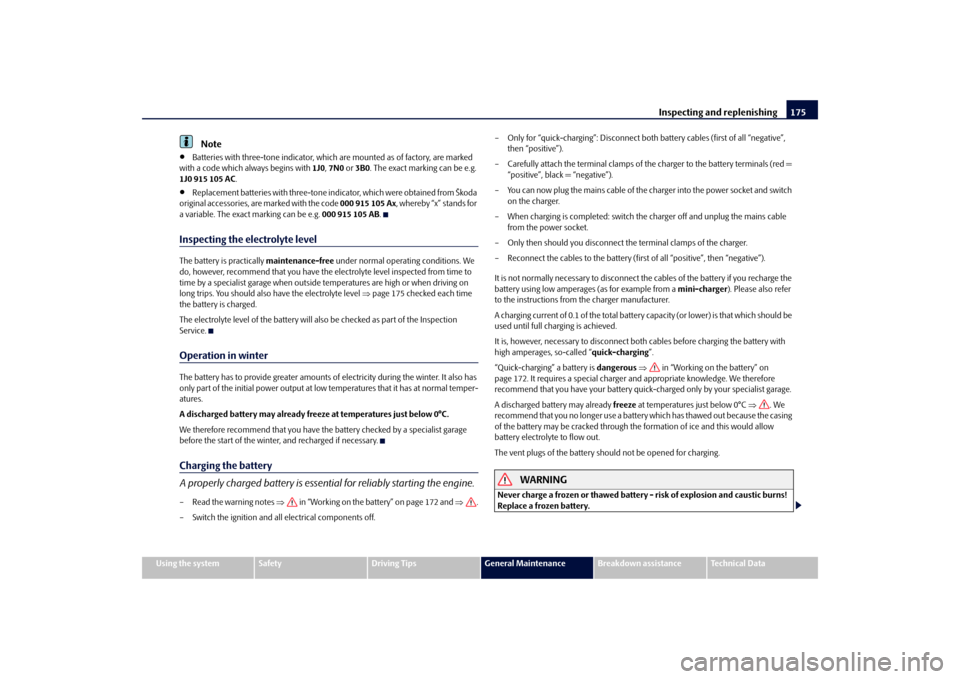
Inspecting and replenishing
175
Using the system
Safety
Driving Tips
General Maintenance
Breakdown assistance
Technical Data
Note
Batteries with three-tone indicator, which are mounted as of factory, are marked
with a code which always begins with
1J0
, 7N0
or 3B0
. The exact marking can be e.g.
1J0 915 105 AC
.
Replacement batteries with three-tone indi
cator, which were obtained from Škoda
original accessories, are marked with the code
000 915 105 Ax
, whereby “x” stands for
a variable. The exact marking can be e.g.
000 915 105 AB
.
Inspecting the electrolyte levelThe battery is practically
maintenance-free
under normal operating conditions. We
do, however, recommend that you have the electrolyte level inspected from time to time by a specialist garage when outside
temperatures are high or when driving on
long trips. You should also have the electrolyte level
page 175 checked each time
the battery is charged. The electrolyte level of the battery will al
so be checked as part of the Inspection
Service.Operation in winterThe battery has to provide greater amounts of
electricity during the winter. It also has
only part of the initial power output at low temperatures that it has at normal temper-atures. A discharged battery may already freez
e at temperatures just below 0°C.
We therefore recommend that you have the
battery checked by a specialist garage
before the start of the winter, and recharged if necessary.Charging the battery A properly charged battery is essentia
l for reliably starting the engine.
– Read the warning notes
in “Working on the battery” on page 172 and
.
– Switch the ignition and all electrical components off.
– Only for “quick-charging”: Disconnect both
battery cables (first
of all “negative”,
then “positive”).
– Carefully attach the terminal
clamps of the charger to the battery terminals (red =
“positive”, black = “negative”).
– You can now plug the mains cable of the
charger into the power socket and switch
on the charger.
– When charging is completed: switch th
e charger off and unplug the mains cable
from the power socket.
– Only then should you disconnect th
e terminal clamps of the charger.
– Reconnect the cables to the battery (first of all “positive”, then “negative”). It is not normally necessary to
disconnect the cables of th
e battery if you recharge the
battery using low amperages (as for example from a
mini-charger
). Please also refer
to the instructions from the charger manufacturer. A charging current of 0.1 of the total battery
capacity (or lower) is that which should be
used until full charging is achieved. It is, however, necessary to disconnect both
cables before charging the battery with
high amperages, so-called “
quick-charging
”.
“Quick-charging” a battery is
dangerous
in “Working on the battery” on
page 172. It requires a special charger an
d appropriate knowledge. We therefore
recommend that you have your battery quick-
charged only by your specialist garage.
A discharged battery may already
freeze
at temperatures just below 0°C
. We
recommend that you no longer use a battery
which has thawed out because the casing
of the battery may be cracked through the formation of ice and this would allow battery electrolyte to flow out. The vent plugs of the battery should not be opened for charging.
WARNING
Never charge a frozen or thawed battery - risk of explosion and caustic burns! Replace a frozen battery.
s3j8.a.book Page 175 Tuesday, April 20, 2010 1:10 PM
Page 177 of 244
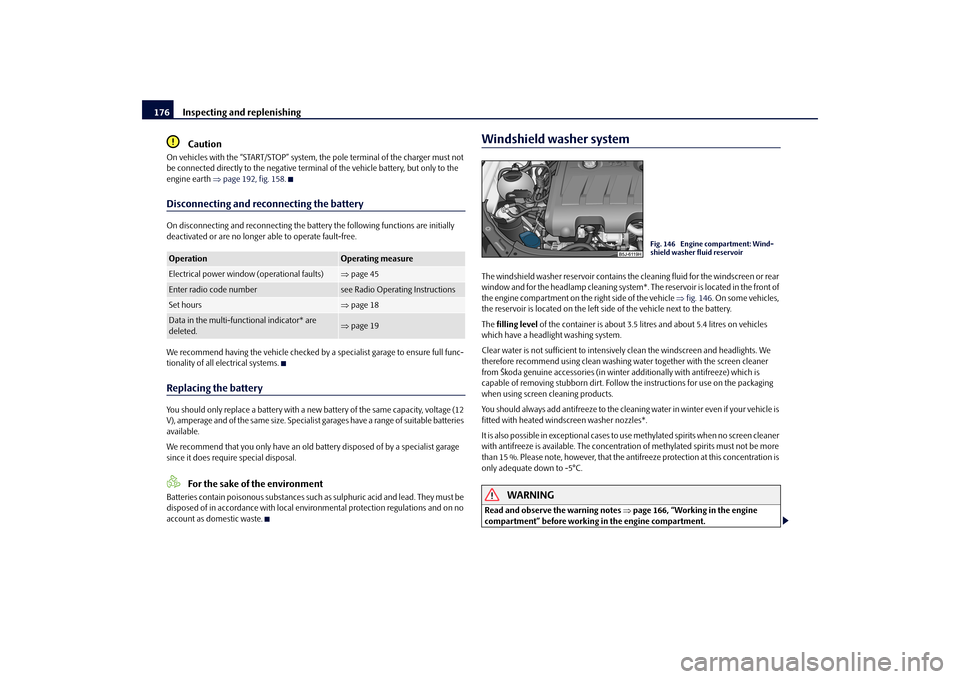
Inspecting and replenishing
176
Caution
On vehicles with the “START/STOP” system,
the pole terminal of the charger must not
be connected directly to the negative termin
al of the vehicle battery, but only to the
engine earth
page 192, fig. 158
.
Disconnecting and reconnecting the batteryOn disconnecting and reconnecting the batt
ery the following functions are initially
deactivated or are no longer able to operate fault-free. We recommend having the vehicle checked by a specialist garage to ensure full func- tionality of all electrical systems.Replacing the batteryYou should only replace a battery with a ne
w battery of the same
capacity, voltage (12
V), amperage and of the same size. Specialist garages have a range of suitable batteries available. We recommend that you only have an old ba
ttery disposed of by a specialist garage
since it does require special disposal.
For the sake of the environment
Batteries contain poisonous substances such
as sulphuric acid and lead. They must be
disposed of in accordance with local environmental protection regulations and on no account as domestic waste.
Windshield washer systemThe windshield washer reservoir contains the
cleaning fluid for the
windscreen or rear
window and for the headlamp cleaning system*.
The reservoir is located in the front of
the engine compartment on the right side of the vehicle
fig. 146
. On some vehicles,
the reservoir is located on the left si
de of the vehicle next to the battery.
The
filling level
of the container is about 3.5 litres and about 5.4 litres on vehicles
which have a headlight washing system. Clear water is not sufficient to intensivel
y clean the windscreen and headlights. We
therefore recommend using clean washing water together with the screen cleaner from Škoda genuine accessories (in winter additionally with antifreeze) which is capable of removing stubborn
dirt. Follow the instructions for use on the packaging
when using screen cleaning products. You should always add antifreeze to the cleani
ng water in winter even
if your vehicle is
fitted with heated wind
screen washer nozzles*.
It is also possible in exceptional cases to use methylated spirits when no screen cleaner with antifreeze is available. The concentration of methylated spirits must not be more than 15 %. Please note, however, that the anti
freeze protection at this concentration is
only adequate down to -5°C.
WARNING
Read and observe the warning notes
page 166, “Working in the engine
compartment” before working in the engine compartment.
Operation
Operating measure
Electrical power window
(operational faults)
page 45
Enter radio code number
see Radio Operat
ing Instructions
Set hours
page 18
Data in the multi-functional indicator* are deleted.
page 19
Fig. 146 Engine compartment: Wind- shield washer fluid reservoir
s3j8.a.book Page 176 Tuesday, April 20, 2010 1:10 PM
Page 191 of 244
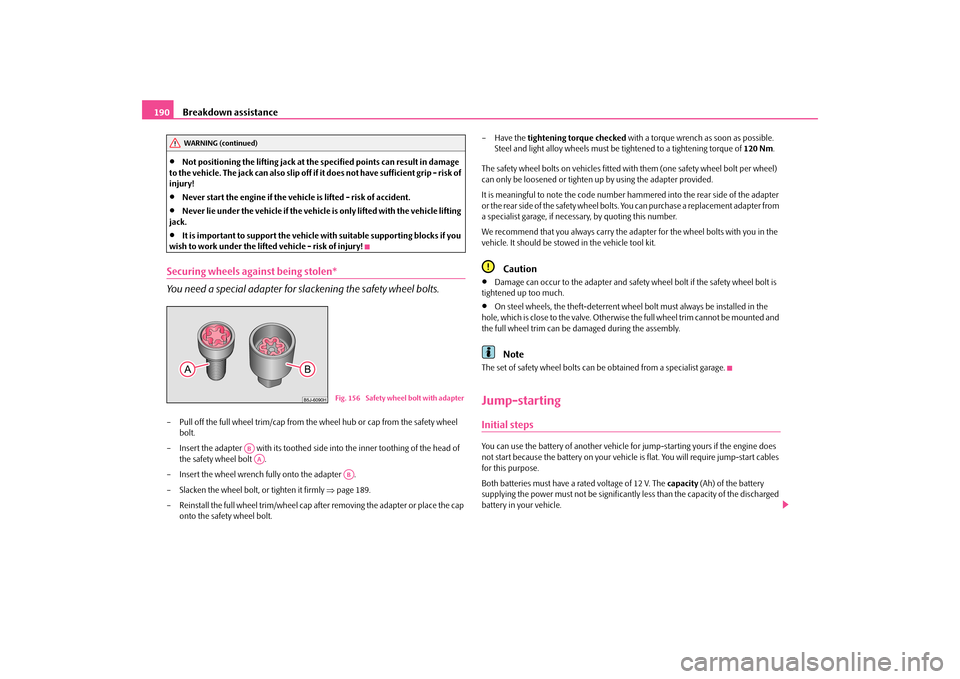
Breakdown assistance
190
Not positioning the lifting jack at the specified points can result in damage
to the vehicle. The jack can also slip off if it does not have sufficient grip - risk of injury!
Never start the engine if the vehicle is lifted - risk of accident.
Never lie under the vehicle if the vehicle is only lifted with the vehicle lifting
jack.
It is important to support the vehicle with suitable supporting blocks if you
wish to work under the lifted vehicle - risk of injury!Securing wheels against being stolen* You need a special adapter for sl
ackening the safety wheel bolts.
– Pull off the full wheel trim/cap from the wheel hub or cap from the safety wheel
bolt.
– Insert the adapter with its toothed side
into the inner toothing of the head of
the safety wheel bolt .
– Insert the wheel wrench fully onto the adapter .– Slacken the wheel bolt, or tighten it firmly
page 189.
– Reinstall the full wheel trim/wheel cap afte
r removing the adapter or place the cap
onto the safety wheel bolt.
– Have the
tightening torque
checked
with a torque wrench as soon as possible.
Steel and light alloy wheels must be tightened to a tightening torque of
120 Nm
.
The safety wheel bolts on vehicles fitted with them (one safety wheel bolt per wheel) can only be loosened or tighten
up by using the adapter provided.
It is meaningful to note th
e code number hammered into the rear side of the adapter
or the rear side of the safety wheel bolts. You can purchase a replacement adapter from a specialist garage, if necessary, by quoting this number. We recommend that you always carry the ad
apter for the wheel bolts with you in the
vehicle. It should be stow
ed in the vehicle tool kit.
Caution
Damage can occur to the adapter and safety
wheel bolt if the safety wheel bolt is
tightened up too much.
On steel wheels, the theft-deterrent wheel
bolt must always be installed in the
hole, which is close to the valve. Otherwise
the full wheel trim cannot be mounted and
the full wheel trim can be damaged during the assembly.
Note
The set of safety wheel bolts can be
obtained from a specialist garage.
Jump-startingInitial stepsYou can use the battery of another vehicle fo
r jump-starting yours if the engine does
not start because the battery on your vehicle
is flat. You will require jump-start cables
for this purpose. Both batteries must have a rated voltage of 12 V. The
capacity
(Ah) of the battery
supplying the power must not be significantly
less than the capacity of the discharged
battery in your vehicle.
WARNING (continued)
Fig. 156 Safety wheel bolt with adapter
ABAA
AB
s3j8.a.book Page 190 Tuesday, April 20, 2010 1:10 PM
Page 192 of 244
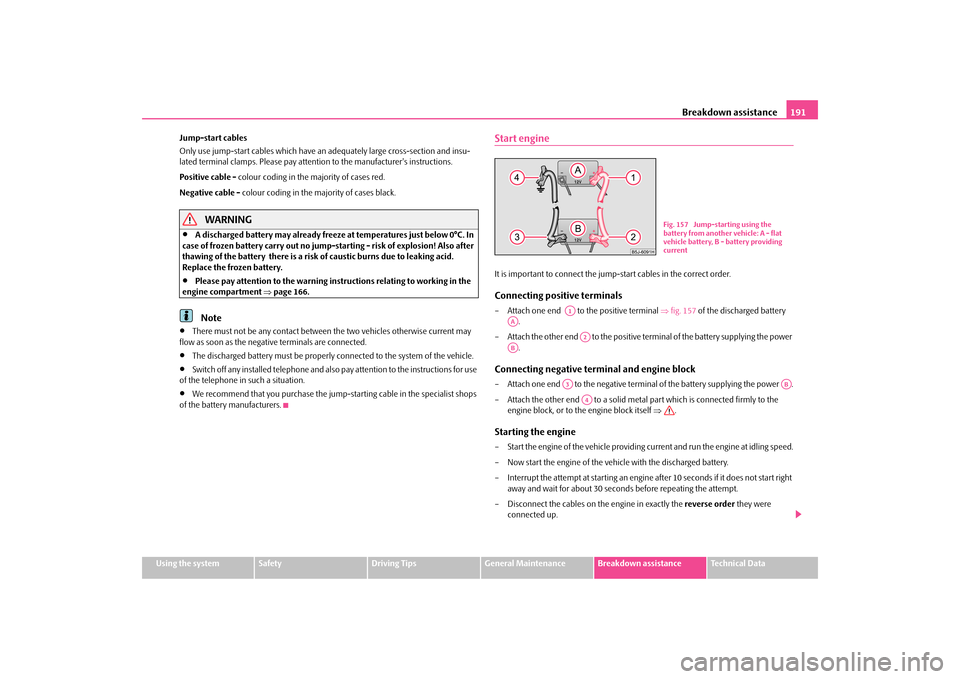
Breakdown assistance
191
Using the system
Safety
Driving Tips
General Maintenance
Breakdown assistance
Technical Data
Jump-start cables Only use jump-start cables which have an
adequately large cross-section and insu-
lated terminal clamps. Plea
se pay attention to the manufacturer's instructions.
Positive cable -
colour coding in the
majority of cases red.
Negative cable -
colour coding in the
majority of cases black.
WARNING
A discharged battery may already freeze
at temperatures just below 0°C. In
case of frozen battery carry out no jump-starting - risk of explosion! Also after thawing of the battery there is a risk
of caustic burns due to leaking acid.
Replace the frozen battery.
Please pay attention to the warning instructions relating to working in the
engine compartment
page 166.
Note
There must not be any contact between
the two vehicles otherwise current may
flow as soon as the negati
ve terminals are connected.
The discharged battery must be properly
connected to the system of the vehicle.
Switch off any installed telephone and also pay attention to the instructions for use
of the telephone in such a situation.
We recommend that you purchase the jump-starting cable in the specialist shops
of the battery manufacturers.
Start engineIt is important to connect the jump-start cables in the correct order.Connecting positive terminals– Attach one end to the positive terminal
fig. 157
of the discharged battery
.
– Attach the other end to the positive te
rminal of the battery supplying the power
.
Connecting negative term
inal and engine block
– Attach one end to the negative termin
al of the battery supplying the power .
– Attach the other end to a solid metal
part which is connected firmly to the
engine block, or to the engine block itself
.
Starting the engine– Start the engine of the vehicle providing
current and run the engine at idling speed.
– Now start the engine of the vehicle with the discharged battery. – Interrupt the attempt at starting an engine after 10 seconds if it does not start right
away and wait for about 30 seconds before repeating the attempt.
– Disconnect the cables on the engine in exactly the
reverse order
they were
connected up.
Fig. 157 Jump-starting using the battery from another vehicle: A - flat vehicle battery, B - battery providing current
A1
AA
A2
AB
A3
AB
A4
s3j8.a.book Page 191 Tuesday, April 20, 2010 1:10 PM
Page 193 of 244
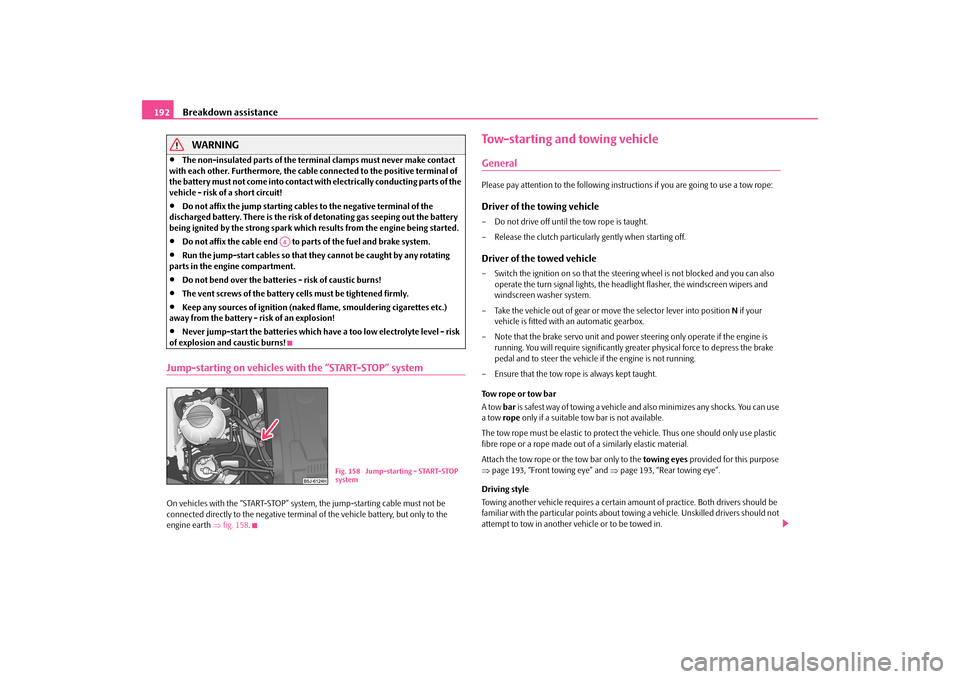
Breakdown assistance
192
WARNING
The non-insulated parts of the terminal clamps must never make contact
with each other. Furthermore, the cable connected to the positive terminal of the battery must not come into contact with electrically conducting parts of the vehicle - risk of a short circuit!
Do not affix the jump starting cables to the negative terminal of the
discharged battery. There is
the risk of detonating gas seeping out the battery
being ignited by the strong spark which
results from the engine being started.
Do not affix the cable end to parts of the fuel and brake system.
Run the jump-start cables so that they cannot be caught by any rotating
parts in the engine compartment.
Do not bend over the batteries - risk of caustic burns!
The vent screws of the battery
cells must be tightened firmly.
Keep any sources of ignition (naked
flame, smouldering
cigarettes etc.)
away from the battery - risk of an explosion!
Never jump-start the batteries which have a too low electrolyte level - risk
of explosion and caustic burns!Jump-starting on vehicles with the “START-STOP” systemOn vehicles with the “START-STOP” syst
em, the jump-starting cable must not be
connected directly to the negative terminal
of the vehicle battery, but only to the
engine earth
fig. 158
.
Tow-starting and towing vehicleGeneralPlease pay attention to the following instru
ctions if you are going to use a tow rope:
Driver of the towing vehicle– Do not drive off until the tow rope is taught. – Release the clutch particularly gently when starting off.Driver of the towed vehicle– Switch the ignition on so that the steeri
ng wheel is not blocked and you can also
operate the turn signal lights, the headlight flasher, the windscreen wipers and windscreen washer system.
– Take the vehicle out of gear or move the selector lever into position
N if your
vehicle is fitted with an automatic gearbox.
– Note that the brake servo unit and power steering only operate if the engine is
running. You will require significantly greater physical force to depress the brake pedal and to steer the vehicle
if the engine is not running.
– Ensure that the tow rope is always kept taught. Tow rope or tow bar A tow
bar
is safest way of towing a vehicle and also minimizes any shocks. You can use
a tow
rope
only if a suitable tow bar is not available.
The tow rope must be elastic to protect the
vehicle. Thus one shou
ld only use plastic
fibre rope or a rope made out
of a similarly elastic material.
Attach the tow rope or the tow bar only to the
towing eyes
provided for this purpose
page 193, “Front towing eye” and
page 193, “Rear towing eye”.
Driving style Towing another vehicle requires a certain am
ount of practice. Both drivers should be
familiar with the particular points about to
wing a vehicle. Unskilled drivers should not
attempt to tow in another vehicle or to be towed in.
A4
Fig. 158 Jump-starting - START-STOP system
s3j8.a.book Page 192 Tuesday, April 20, 2010 1:10 PM
Page 198 of 244
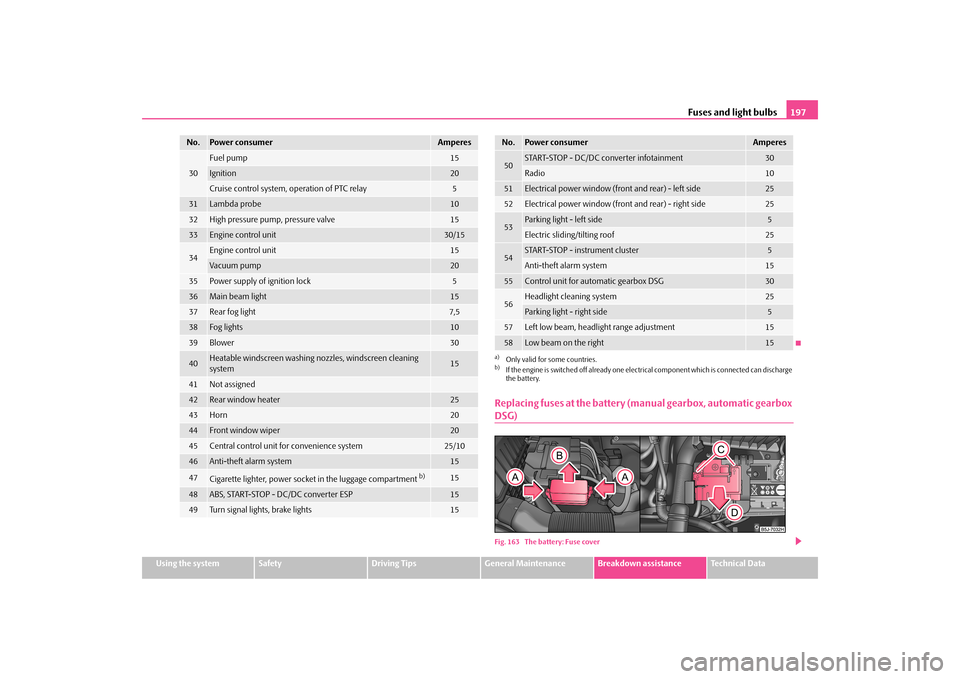
Fuses and light bulbs
197
Using the system
Safety
Driving Tips
General Maintenance
Breakdown assistance
Technical Data
Replacing fuses at the battery (manual gearbox, automatic gearbox DSG)Fig. 163 The battery: Fuse cover
30
Fuel pump
15
Ignition
20
Cruise control system, operation of PTC relay
5
31
Lambda probe
10
32
High pressure pump, pressure valve
15
33
Engine control unit
30/15
34
Engine control unit
15
Vacuum pump
20
35
Power supply of ignition lock
5
36
Main beam light
15
37
Rear fog light
7,5
38
Fog lights
10
39
Blower
30
40
Heatable windscreen washing no
zzles, windscreen cleaning
system
15
41
Not assigned
42
Rear window heater
25
43
Horn
20
44
Front window wiper
20
45
Central control unit fo
r convenience system
25/10
46
Anti-theft alarm system
15
47
Cigarette lighter, power socket in the luggage compartment
b)
15
48
ABS, START-STOP - DC/DC converter ESP
15
49
Turn signal lights, brake lights
15
No.
Power consumer
Amperes
50
START-STOP - DC/DC converter infotainment
30
Radio
10
51
Electrical power window (front and rear) - left side
25
52
Electrical power window (front and rear) - right side
25
53
Parking light - left side
5
Electric sliding/tilting roof
25
54
START-STOP - instrument cluster
5
Anti-theft alarm system
15
55
Control unit for automatic gearbox DSG
30
56
Headlight cleaning system
25
Parking light - right side
5
57
Left low beam, headlight range adjustment
15
58
Low beam on the right
15
a)Only valid for some countries.b)If the engine is switched off already one electr
ical component which is
connected can discharge
the battery.No.
Power consumer
Amperes
s3j8.a.book Page 197 Tuesday, April 20, 2010 1:10 PM
Page 199 of 244
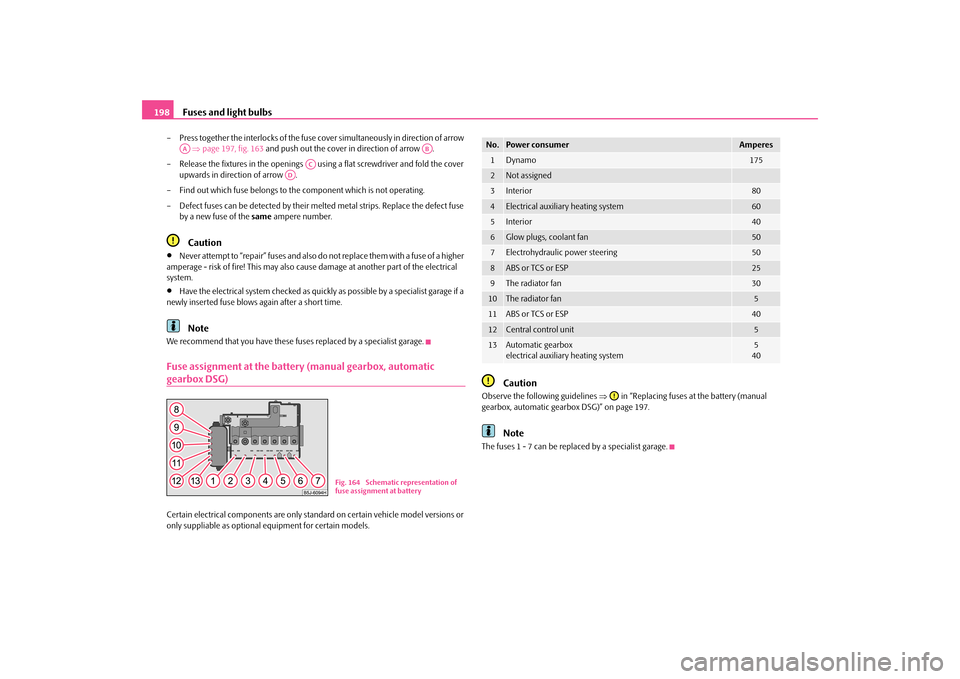
Fuses and light bulbs
198
– Press together the interlocks of the fuse
cover simultaneously in direction of arrow
page 197, fig. 163
and push out the cover in direction of arrow .
– Release the fixtures in the openings using a flat screwdriver and fold the cover
upwards in direction of arrow .
– Find out which fuse belongs to th
e component which is not operating.
– Defect fuses can be detected by their melted metal strips. Replace the defect fuse
by a new fuse of the
same
ampere number.
Caution
Never attempt to “repair” fuses and also do
not replace them with a fuse of a higher
amperage - risk of fire! This
may also cause damage at an
other part of the electrical
system.
Have the electrical system checked as quickl
y as possible by a specialist garage if a
newly inserted fuse blows again after a short time.
Note
We recommend that you have these fuse
s replaced by a specialist garage.
Fuse assignment at the battery (manual gearbox, automatic gearbox DSG)Certain electrical components are only standard on certain vehicle model versions or only suppliable as optional
equipment for certain models.
Caution
Observe the following guidelines
in “Replacing fuses at the battery (manual
gearbox, automatic gearbox DSG)” on page 197.
Note
The fuses 1 - 7 can be replac
ed by a specialist garage.
AA
AB
AC
AD
Fig. 164 Schematic representation of fuse assignment at battery
No.
Power consumer
Amperes
1
Dynamo
175
2
Not assigned
3
Interior
80
4
Electrical auxiliary heating system
60
5
Interior
40
6
Glow plugs, coolant fan
50
7
Electrohydraulic power steering
50
8
ABS or TCS or ESP
25
9
The radiator fan
30
10
The radiator fan
5
11
ABS or TCS or ESP
40
12
Central control unit
5
13
Automatic gearbox electrical auxiliary heating system
540
s3j8.a.book Page 198 Tuesday, April 20, 2010 1:10 PM
Page 200 of 244
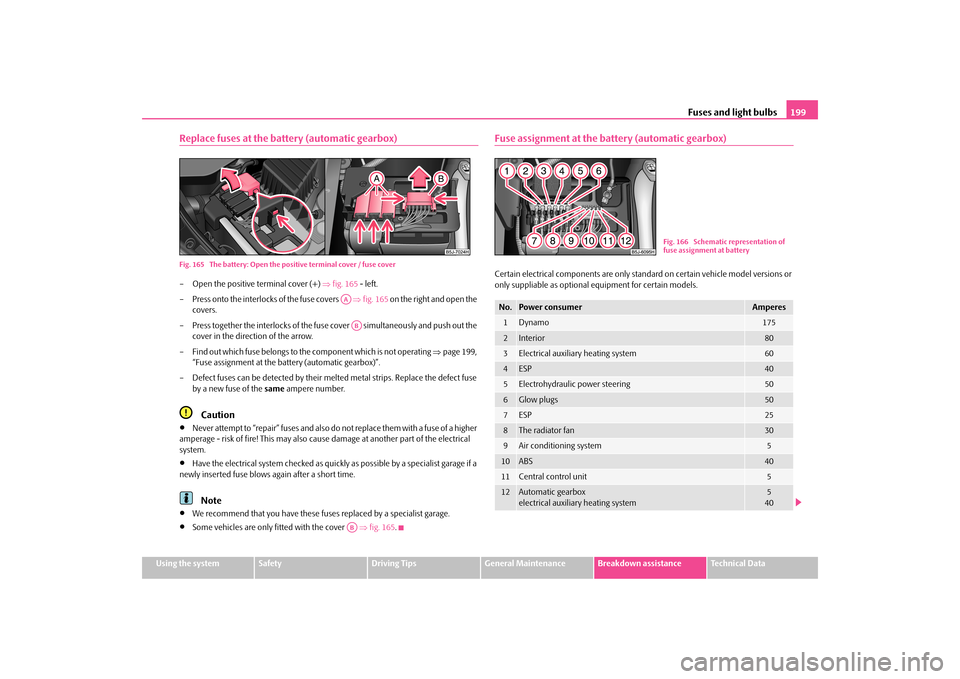
Fuses and light bulbs
199
Using the system
Safety
Driving Tips
General Maintenance
Breakdown assistance
Technical Data
Replace fuses at the battery (automatic gearbox)Fig. 165 The battery: Open the posi
tive terminal cover / fuse cover
– Open the positive terminal cover (+)
fig. 165
- left.
– Press onto the interlocks of the fuse covers
fig. 165
on the right and open the
covers.
– Press together the interlocks of the fuse
cover simultaneously and push out the
cover in the direction of the arrow.
– Find out which fuse belongs to th
e component which is not operating
page 199,
“Fuse assignment at the ba
ttery (automatic gearbox)”.
– Defect fuses can be detected by their melted metal strips. Replace the defect fuse
by a new fuse of the
same
ampere number.
Caution
Never attempt to “repair” fuses and also do
not replace them with a fuse of a higher
amperage - risk of fire! This
may also cause damage at an
other part of the electrical
system.
Have the electrical system checked as quickl
y as possible by a specialist garage if a
newly inserted fuse blows again after a short time.
Note
We recommend that you have these fuse
s replaced by a specialist garage.
Some vehicles are only fitted with the cover
fig. 165
.
Fuse assignment at the battery (automatic gearbox)Certain electrical components are only stan
dard on certain vehicl
e model versions or
only suppliable as optional
equipment for certain models.
AAABAB
No.
Power consumer
Amperes
1
Dynamo
175
2
Interior
80
3
Electrical auxiliary heating system
60
4
ESP
40
5
Electrohydraulic power steering
50
6
Glow plugs
50
7
ESP
25
8
The radiator fan
30
9
Air conditioning system
5
10
ABS
40
11
Central control unit
5
12
Automatic gearbox electrical auxiliary heating system
540
Fig. 166 Schematic representation of fuse assignment at battery
s3j8.a.book Page 199 Tuesday, April 20, 2010 1:10 PM
Page 201 of 244
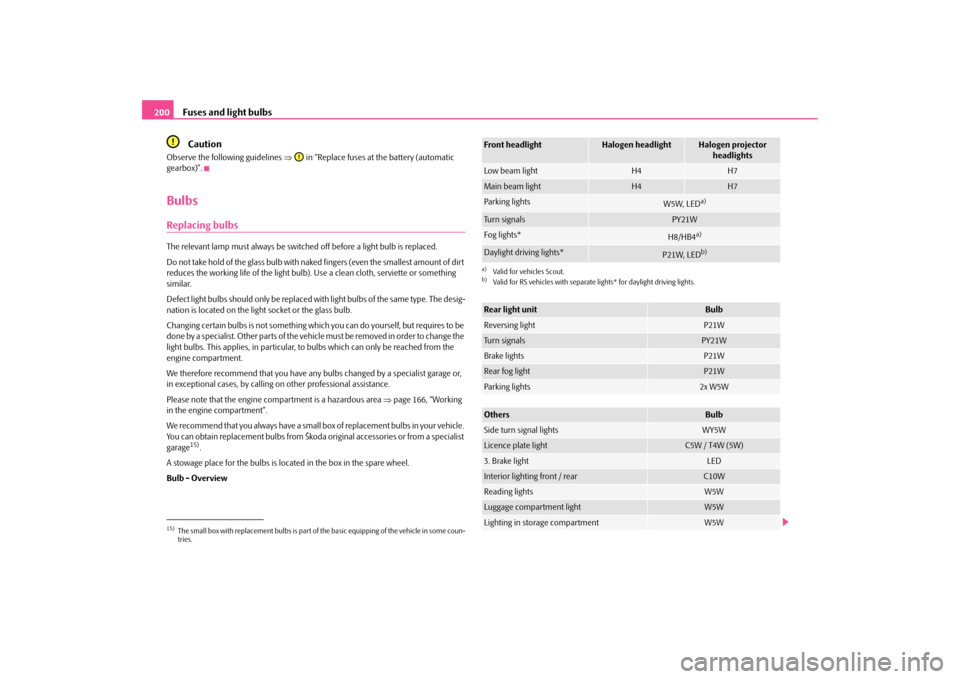
Fuses and light bulbs
200
Caution
Observe the following guidelines
in “Replace fuses at the battery (automatic
gearbox)”.BulbsReplacing bulbsThe relevant lamp must always be switch
ed off before a light bulb is replaced.
Do not take hold of the glass bulb with naked fingers (even the smallest amount of dirt reduces the working life of the light bulb).
Use a clean cloth, serviette or something
similar. Defect light bulbs should only be replaced
with light bulbs of the same type. The desig-
nation is located on the ligh
t socket or the glass bulb.
Changing certain bulbs is not something whic
h you can do yourself, but requires to be
done by a specialist. Other parts of the vehicle must be removed in order to change the light bulbs. This applies, in particular, to
bulbs which can only be reached from the
engine compartment. We therefore recommend that you have any
bulbs changed by a specialist garage or,
in exceptional cases, by calling
on other professional assistance.
Please note that the engine compartment is a hazardous area
page 166, “Working
in the engine compartment”. We recommend that you always have a small box of replacement bulbs in your vehicle. You can obtain replacement bulbs from Škoda
original accessories or from a specialist
garage
15).
A stowage place for the bulbs is located in the box in the spare wheel.Bulb - Overview15)The small box with replacement bulbs is part of
the basic equipping of th
e vehicle in some coun-
tries.
Front headlight
Halogen headlight
Halogen projector
headlights
Low beam light
H4
H7
Main beam light
H4
H7
Parking lights
W5W, LED
a)
a)Valid for vehicles Scout.Turn signals
PY21W
Fog lights*
H8/HB4
a)
Daylight driving lights*
P21W, LED
b)
b)Valid for RS vehicles with separate lights* for daylight driving lights.Rear light unit
Bulb
Reversing light
P21W
Turn signals
PY21W
Brake lights
P21W
Rear fog light
P21W
Parking lights
2x W5W
Others
Bulb
Side turn signal lights
WY5W
Licence plate light
C5W / T4W (5W)
3. Brake light
LED
Interior lighting front / rear
C10W
Reading lights
W5W
Luggage compartment light
W5W
Lighting in storage compartment
W5W
s3j8.a.book Page 200 Tuesday, April 20, 2010 1:10 PM
Page 236 of 244
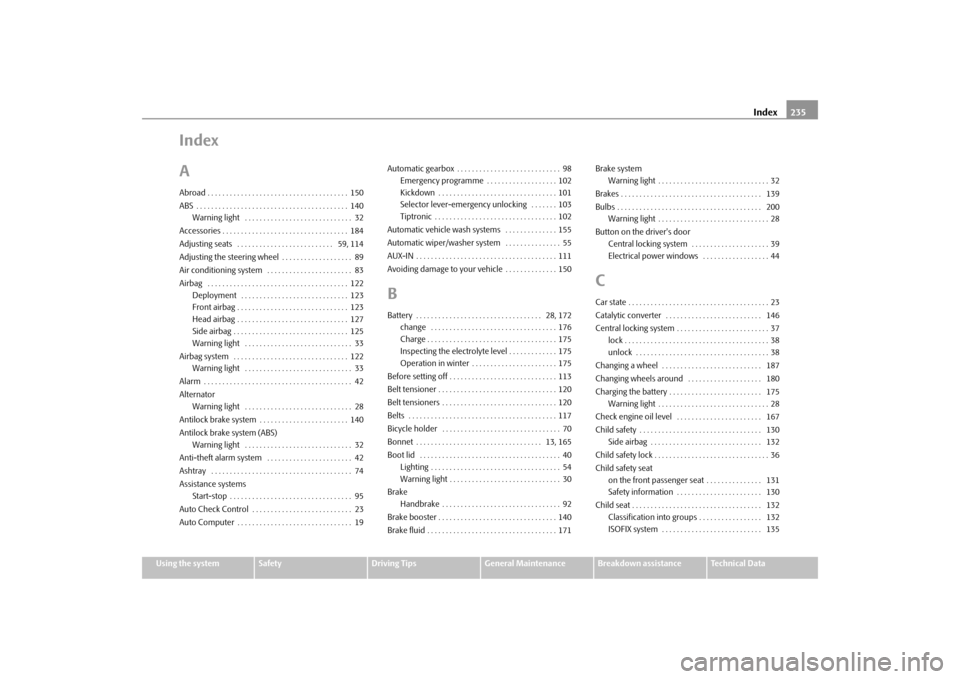
Index235
Using the system
Safety
Driving Tips
General Maintenance
Breakdown assistance
Technical Data
Index
AAbroad . . . . . . . . . . . . . . . . . . . . . . . . . . . . . . . . . . . . . . 150
ABS . . . . . . . . . . . . . . . . . . . . . . . . . . . . . . . . . . . . . . . . . 140
Warning light . . . . . . . . . . . . . . . . . . . . . . . . . . . . . 32
Accessories . . . . . . . . . . . . . . . . . . . . . . . . . . . . . . . . . . 184
Adjusting seats . . . . . . . . . . . . . . . . . . . . . . . . . . 59, 114
Adjusting the steering wheel . . . . . . . . . . . . . . . . . . . 89
Air conditioning system . . . . . . . . . . . . . . . . . . . . . . . 83
Airbag . . . . . . . . . . . . . . . . . . . . . . . . . . . . . . . . . . . . . . 122
Deployment . . . . . . . . . . . . . . . . . . . . . . . . . . . . . 123
Front airbag . . . . . . . . . . . . . . . . . . . . . . . . . . . . . . 123
Head airbag . . . . . . . . . . . . . . . . . . . . . . . . . . . . . . 127
Side airbag . . . . . . . . . . . . . . . . . . . . . . . . . . . . . . . 125
Warning light . . . . . . . . . . . . . . . . . . . . . . . . . . . . . 33
Airbag system . . . . . . . . . . . . . . . . . . . . . . . . . . . . . . . 122
Warning light . . . . . . . . . . . . . . . . . . . . . . . . . . . . . 33
Alarm . . . . . . . . . . . . . . . . . . . . . . . . . . . . . . . . . . . . . . . . 42
Alternator
Warning light . . . . . . . . . . . . . . . . . . . . . . . . . . . . . 28
Antilock brake system . . . . . . . . . . . . . . . . . . . . . . . . 140
Antilock brake system (ABS)
Warning light . . . . . . . . . . . . . . . . . . . . . . . . . . . . . 32
Anti-theft alarm system . . . . . . . . . . . . . . . . . . . . . . . 42
Ashtray . . . . . . . . . . . . . . . . . . . . . . . . . . . . . . . . . . . . . . 74
Assistance systems
Start-stop . . . . . . . . . . . . . . . . . . . . . . . . . . . . . . . . . 95
Auto Check Control . . . . . . . . . . . . . . . . . . . . . . . . . . . 23
Auto Computer . . . . . . . . . . . . . . . . . . . . . . . . . . . . . . . 19Automatic gearbox . . . . . . . . . . . . . . . . . . . . . . . . . . . . 98
Emergency programme . . . . . . . . . . . . . . . . . . . 102
Kickdown . . . . . . . . . . . . . . . . . . . . . . . . . . . . . . . . 101
Selector lever-emergency unlocking . . . . . . . 103
Tiptronic . . . . . . . . . . . . . . . . . . . . . . . . . . . . . . . . . 102
Automatic vehicle wash systems . . . . . . . . . . . . . . 155
Automatic wiper/washer system . . . . . . . . . . . . . . . 55
AUX-IN . . . . . . . . . . . . . . . . . . . . . . . . . . . . . . . . . . . . . . 111
Avoiding damage to your vehicle . . . . . . . . . . . . . . 150
BBattery . . . . . . . . . . . . . . . . . . . . . . . . . . . . . . . . . . 28, 172
change . . . . . . . . . . . . . . . . . . . . . . . . . . . . . . . . . . 176
Charge . . . . . . . . . . . . . . . . . . . . . . . . . . . . . . . . . . . 175
Inspecting the electrolyte level . . . . . . . . . . . . . 175
Operation in winter . . . . . . . . . . . . . . . . . . . . . . . 175
Before setting off . . . . . . . . . . . . . . . . . . . . . . . . . . . . . 113
Belt tensioner . . . . . . . . . . . . . . . . . . . . . . . . . . . . . . . . 120
Belt tensioners . . . . . . . . . . . . . . . . . . . . . . . . . . . . . . . 120
Belts . . . . . . . . . . . . . . . . . . . . . . . . . . . . . . . . . . . . . . . . 117
Bicycle holder . . . . . . . . . . . . . . . . . . . . . . . . . . . . . . . . 70
Bonnet . . . . . . . . . . . . . . . . . . . . . . . . . . . . . . . . . . 13, 165
Boot lid . . . . . . . . . . . . . . . . . . . . . . . . . . . . . . . . . . . . . . 40
Lighting . . . . . . . . . . . . . . . . . . . . . . . . . . . . . . . . . . . 54
Warning light . . . . . . . . . . . . . . . . . . . . . . . . . . . . . . 30
Brake
Handbrake . . . . . . . . . . . . . . . . . . . . . . . . . . . . . . . . 92
Brake booster . . . . . . . . . . . . . . . . . . . . . . . . . . . . . . . . 140
Brake fluid . . . . . . . . . . . . . . . . . . . . . . . . . . . . . . . . . . . 171Brake system
Warning light . . . . . . . . . . . . . . . . . . . . . . . . . . . . . . 32
Brakes . . . . . . . . . . . . . . . . . . . . . . . . . . . . . . . . . . . . . . 139
Bulbs . . . . . . . . . . . . . . . . . . . . . . . . . . . . . . . . . . . . . . . 200
Warning light . . . . . . . . . . . . . . . . . . . . . . . . . . . . . . 28
Button on the driver's door
Central locking system . . . . . . . . . . . . . . . . . . . . . 39
Electrical power windows . . . . . . . . . . . . . . . . . . 44
CCar state . . . . . . . . . . . . . . . . . . . . . . . . . . . . . . . . . . . . . . 23
Catalytic converter . . . . . . . . . . . . . . . . . . . . . . . . . . 146
Central locking system . . . . . . . . . . . . . . . . . . . . . . . . . 37
lock . . . . . . . . . . . . . . . . . . . . . . . . . . . . . . . . . . . . . . . 38
unlock . . . . . . . . . . . . . . . . . . . . . . . . . . . . . . . . . . . . 38
Changing a wheel . . . . . . . . . . . . . . . . . . . . . . . . . . . 187
Changing wheels around . . . . . . . . . . . . . . . . . . . . 180
Charging the battery . . . . . . . . . . . . . . . . . . . . . . . . . 175
Warning light . . . . . . . . . . . . . . . . . . . . . . . . . . . . . . 28
Check engine oil level . . . . . . . . . . . . . . . . . . . . . . . 167
Child safety . . . . . . . . . . . . . . . . . . . . . . . . . . . . . . . . . 130
Side airbag . . . . . . . . . . . . . . . . . . . . . . . . . . . . . . 132
Child safety lock . . . . . . . . . . . . . . . . . . . . . . . . . . . . . . . 36
Child safety seat
on the front passenger seat . . . . . . . . . . . . . . . 131
Safety information . . . . . . . . . . . . . . . . . . . . . . . 130
Child seat . . . . . . . . . . . . . . . . . . . . . . . . . . . . . . . . . . . 132
Classification into groups . . . . . . . . . . . . . . . . . 132
ISOFIX system . . . . . . . . . . . . . . . . . . . . . . . . . . . 135
s3j8.a.book Page 235 Tuesday, April 20, 2010 1:10 PM